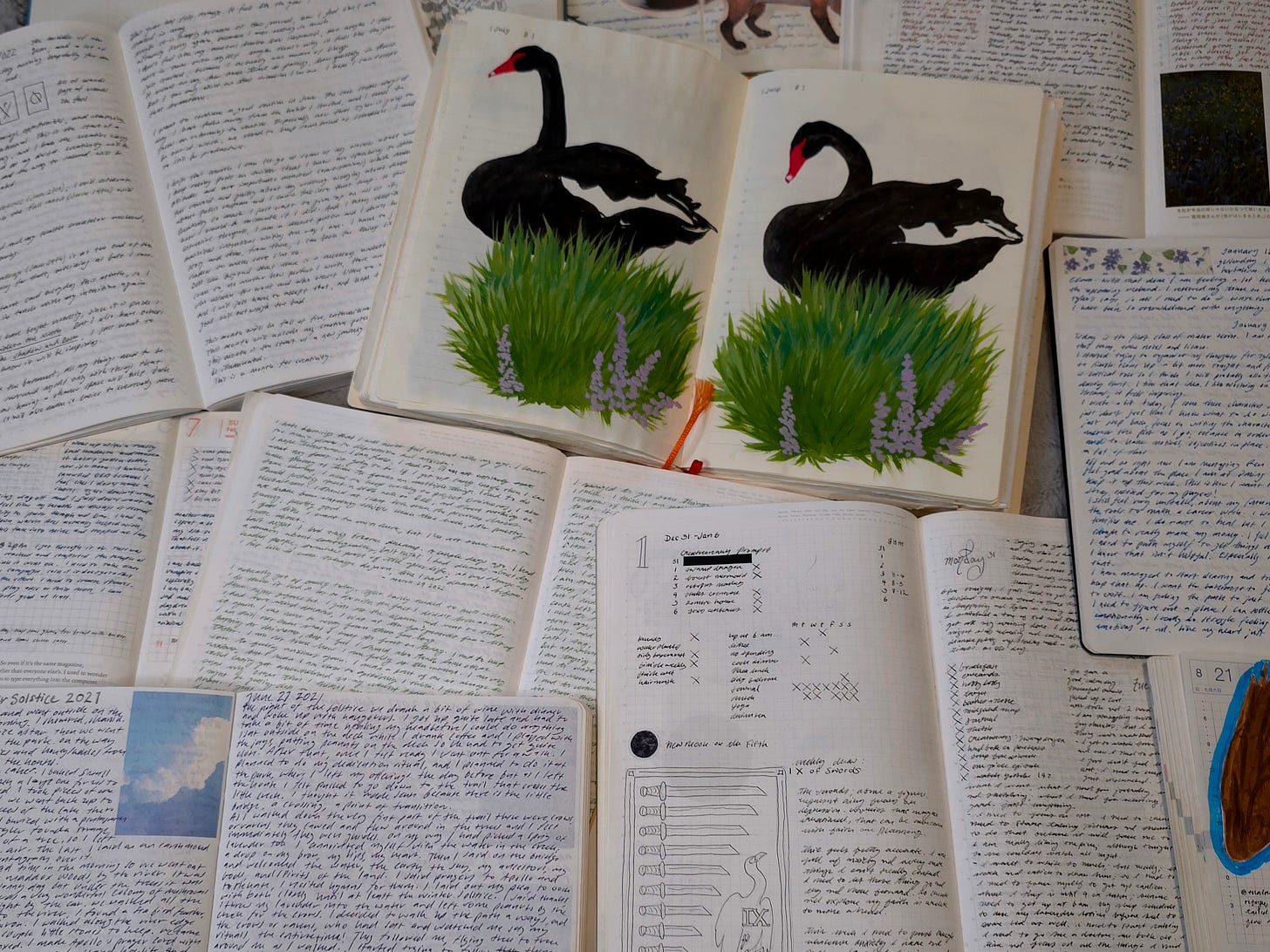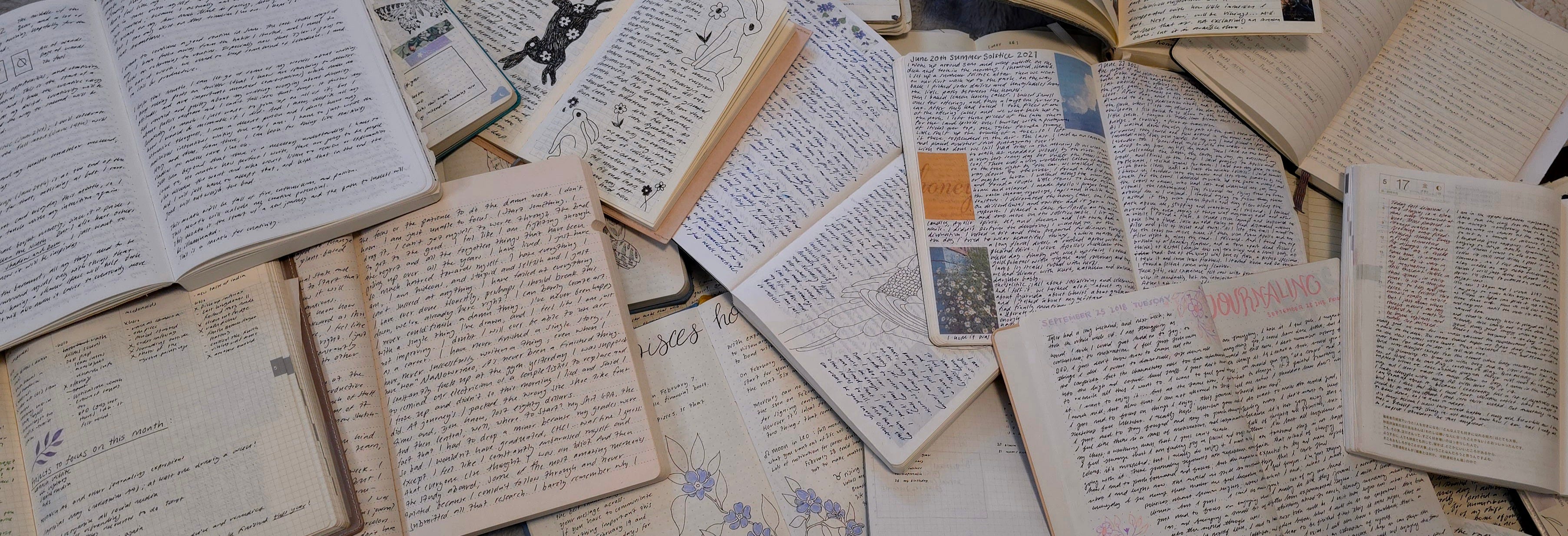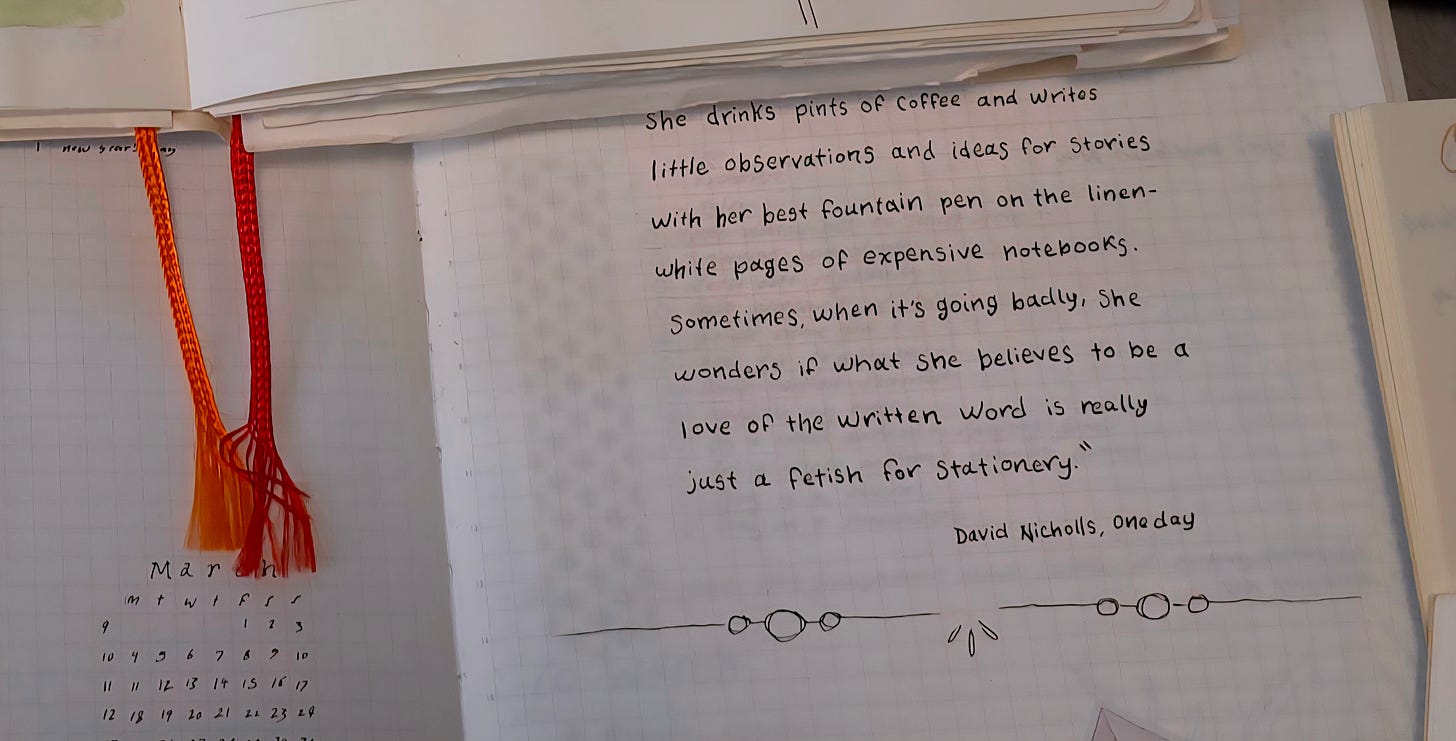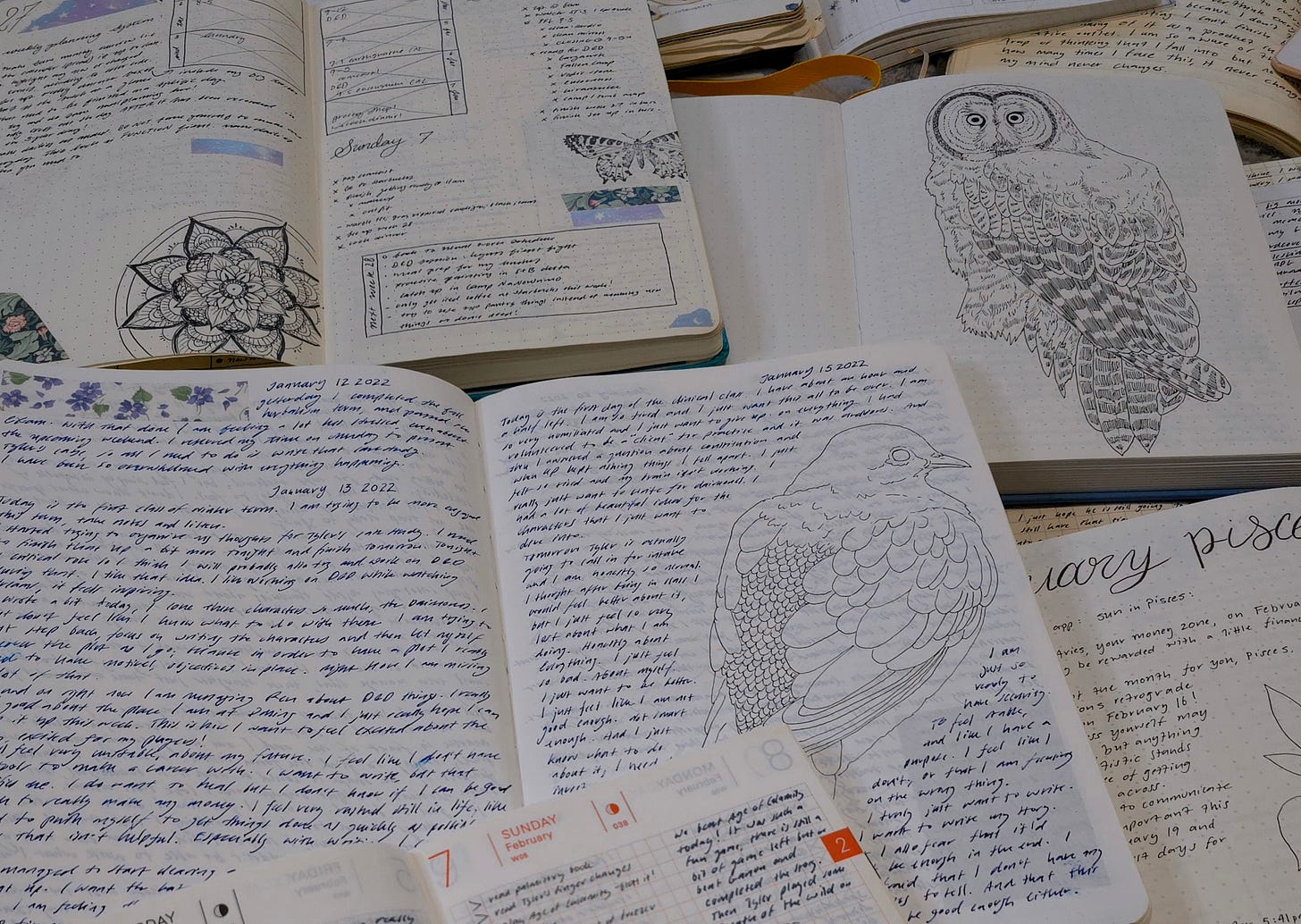Is journaling finally working for me?
reflecting on my journaling practices in the past and what is working for me in the present
Disclaimer: Journaling is an incredibly personal thing and means something different to everyone, so keep in mind this is just my personal experience. But if you have had similar struggles, I hope you can get some inspiration from my thought process.
I’ve been journaling as long as I can remember but it was always a toxic relationship. I love the hobby, but it was more like I was chasing an ideal rather than journaling for myself. I struggled with perfectionism, ripping pages out, trying to start over every time I made a mistake.
But this past year I started really breaking down why journaling wasn’t working for me. It was something I wanted to do, something I enjoyed doing (most of the time). So why didn’t I feel comfortable? Why did I keep trying to start with new systems, new books, new methods?
it’s me— hi — I’m the problem, it’s me
I started really thinking about how I felt. Especially in moments when I wanted to switch things up, or totally change gears. I forced myself to stop and reflect on: why? Why do I want to change?
I realized a couple things about myself as I analyzed my patterns.
First, I was scared (yes, scared) of archiving things.
I think this has roots from some of my childhood trauma and my anxiety in general. I realized that a lot of the time when I started waffling, it was because I felt I was filling pages too fast, or I started wondering how I was going to keep the system consistent across years to come (girl, relax), or I got depressed about the idea that I would never want to re-read those pages again.
All those thought patterns were connected to me keeping finished journals, figuring out how to store them, etc. I wasn’t considering the process of journaling at all, I was focused on the final product, the finished book as a whole and where it would go. But journaling is supposed to be a tool to help you in the present, not something you need to worry about holding onto.
Second, I was worrying about consistency in design and content.
I often change interests, projects, and styles of writing, and I always wanted to switch to a new notebook when I started something new.
Also I would be (still am) easily swayed by seeing how other people journal. When I see an aesthetic I like, I want to try and emulate it. But, of course, that means I want to start a brand new journal to try out that aesthetic. And inevitably I would realize I didn’t actually want to continue that style and would give up (this happened so much, it’s embarrassing).
Also on the point of consistency, I would be very hard on myself if I wasn’t consistent with daily journaling, especially if I had a dated journal. One of the main reasons I journal is to memory keep, so I felt like if I missed a day I had to backfill it. When I would try dated planners in the past, sometimes I would take DAYS to backfill pages I missed and I always felt stressed about it.
So, what changed this year?
I got tired of myself. Honestly, I was over it —and by it I mean: my brain.
I was at the point where I came to the realization that if I couldn’t make journaling a healthy, joyful hobby for me, I needed to stop doing it at all. This pushed me to fix things because the reality was I could never give up journaling. Despite all my issues, I NEED to have a physical place to write down my thoughts otherwise I become a real mess, quickly.
The ultimatum really became a promise to myself to improve.
I still had to test some things out, but my goal was to get to a place where I felt calm and joyful.
I thought about all my struggles and looked for solutions. I went back through old journals and looked for what worked and what didn’t. When did I have the most success? Which journals did I almost succeed in filling? What happened to make me stop?
I also focused on efficiency, I don’t want to be spending hours a day journaling because I feel like I have too, but because I was enjoying the process! I wanted to refocus on journaling as a hobby not a chore.
But I also needed practical things. I needed to make sure I had a place to write to-do lists and events, the basic planner stuff.
I’d tried bullet journaling before but I always fell victim to perfectionism and comparison so I knew better than to try that again.
I thought maybe I should try to keep all my journaling, planning, common-placing in one book. I thought this would help me with my archiving fears, because I would only be storing one book. And I thought it would help my fear of having multiple styles in one book because I would HAVE to use the book for multiple things.
But I quickly realized this wasn’t going to work. First, it was just too much in one book (I write a lot) and it was hard to organize. I ended up having a bunch of sections and pages that I wanted to be able to reference and it was just a mess. Also, I burnt out quickly using the same book.
I needed more variety. But I didn’t want too much variety! I knew better then to spread out into a bunch of separate books. That had been a problem in the past too, I would end up with 20 different journals I was trying to fill all at the same time. I really needed to figure out my goldilocks number. The perfect number of journals that would help my accomplish my goals, aid my productivity and fulfill my creativity.
So I tried to really come up with a list of the things I wanted to journal about/keep record of. I tried to as myself specific questions: How could I have a memory-keeper that was easily archived? How could I balance daily journaling with that memory-keeping system in a way that wasn’t repetitive? I didn’t want to have to write out the same things over and over. I wanted my system to flow, to feel natural to me.
After all that musing, I came up with my list of journals that were non-negotiable and those that were flexible for me. If you are struggling with your journaling system, I think just taking this step, to write out this style of list can be an immense help. At the end I was upset at myself for not doing it sooner, honestly.
My list ended up being pretty short, which surprised me. Stripping everything else away, it turned out I wasn’t looking for as much as I thought. I think we have a tendency to overcomplicate things.
Non-negotiable:
A journal for aesthetic spreads and personal reflection.
A memory keeping diary (that is easily archived).
A planner with space to common-place.
Flexible:
Creative project notebooks.
Non-negotiable 1. A journal for aesthetic spreads and personal reflection.
One big shift in my mindset came from aligning my journaling with astrology. Even just setting aside time to journal every full moon helped immensely. Even if in the future I stop studying astrology, I would still try and journal every full and new moon. It gives me a nice structure, and I can find or set aside prompts I want to use. Of course, I still journal between those phases, but having those set dates is nice and provides consistency that isn’t overwhelming. It’s also a great outlet for doing more aesthetic spreads.
Once I started leaning into that schedule and started allowing myself to make aesthetic pages just for fun, I was able to let go of some of my perfectionism. Knowing that once or twice a month I’d be sitting down and making something pretty helped me feel okay about other pages not living up to my self-imposed high standards.
Non-negotiable 2. A memory keeping diary (that is easily archived).
Next was fixing my archiving fears. The solution was easier than I initially thought: I committed to a 5 year diary. Easy to archive, it’s one book for 5 years! That saves some space. Once I started filling that diary and felt that security, knowing I’d carry that one book with me regardless of whatever else, I stopped worrying so much about the archivable of other journals in my system. If I get to the end of a journal and I want to keep it, that’s great! But I also won’t lose any memories if I recycle it, because I have a place that keeps all those together.
That was a weight off my mind (and if you are in a similar space trying to fix your journaling system I highly recommend trying a 5 year diary) and I felt way more free to be creative in other journals.
Non-negotiable 3. A planner with space to common-place.
I still needed a planner, and I settled on one that gave me a weekly layout and notes pages. That way I could do my to-do lists and my common-placing in the same book. I thought that would work better for me since I often want to reference the things I common-place and this way it’s right there in the planner I open daily. I also found that doing a little bit of memory keeping each day in the weekly section helped me to fill in my 5 year if I missed days. I make sure to always take some daily notes in my planner so if I don’t fill in my 5 year that day, I can just go back to my planner and back fill it from there. It’s way easier to backfill when you aren’t hunting through a bunch of different books and the pressure is off when you know you have at least a couple sentences ready to copy.
Flexible: 1. Creative project notebooks.
Next things to tackle was all my creative projects. As a writer, I always have project notebooks laying around. I tried keeping all my stories in one book and that was an immediate no. I definitely needed each project in a different book. I ended up giving in to my magpie nature and getting decorative, super pretty journals for each story, because I think it is more inspiring and why not? I’m over feeling that “this book is too pretty for me to write in” anxiety. I need to be using the most aesthetic books I can find, I’m here to romanticize every word I write.
Now in a way, these are also non-negotiable, because I will always want to have a project going, but these have to be flexible in the sense that I might put them away on a shelf for a while when I switch up what I’m currently working on.

This was a bit of a ramble, but that’s how my brain figured out what I needed!
I plan on posting about my current journaling eco-system soon; I will be going through each of my current journals/planners to show you exactly how I applied the system I talked about here (and what I ended up adding).




